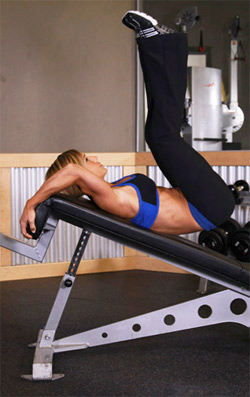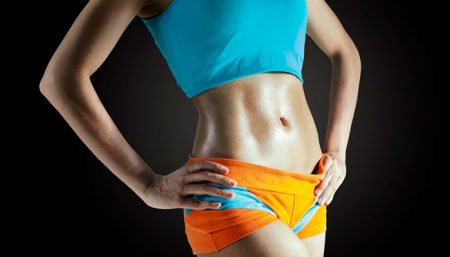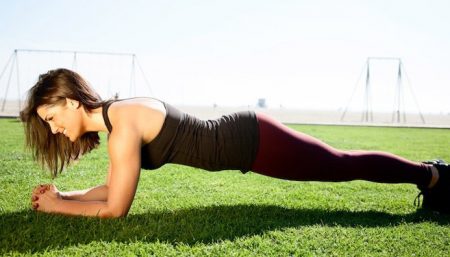Virtually all exercises require us to use our abdominal muscles for stability or mobility, so the abs get a synergistic workout when we do squats, for example.
A San Diego State University study found that abs respond best to exercises that work three sets of muscles at once: the rectus abdominis, which makes up the eight-pack; the muscles to the sides of it, called the obliques; and the hip flexors, which enable us to pull up our knees.
Abs still need some special attention and exercises for them specifically. Below are listed some exciting and challenging ab exercises.

Body Bar Crunches: Knees Bent
Area of focus: upper abs
Instruction: Lie flat on your back with your knees bent and both feet on the floor. Place the body bar between your legs and hold it in front of your chest, one hand on top of the other.
Use your upper abs to raise your shoulder blades of the floor in a forward curling motion, moving the body bar with you. When you reach the top of the movement, extend your arms, pushing the body bar away from your body. Then lower your torso back to the starting position. Repeat the movement. Work up to 20 reps.
Smart Tip
- Keep constant tension on your abs throughout the movement.
- Focus your mind on feeling your upper abs do the work.
- Don’t rest at the bottom of the top of the movement.
- Hold the contraction at the top of the movement.
- Keep a neutral spine.
- Alternate your grip on the way down, changing the bottom hand to the top.
Body Bar Catches
Area of focus: obliques
Instruction: Lie flat on your back with your knees bent and both feet on the floor. Place the body bar outside your left leg, holding it with one hand on top of the other, like an oar. Use your ab muscles to raise your torso diagonally, pushing the body bar up and out at an angle as your hands move outside and above your left knee. Then, in a controlled motion, lower your torso back to the floor. Repeat the movement to the opposite side. Work up to 20 reps on each side.
Smart Tip
- Make sure you get both arms outside the knee and slightly above knee level.
- Keep your lower back supported on the floor.
- Focus your mind on your oblique muscles as you cross from side to side.
- Alternate your grip on the way down, changing the bottom hand to the top.
Body Bar Reverse Crunches
 Area of focus: lower abs
Area of focus: lower abs
Instruction: Lie flat on your back; raise your thighs so your knees are above your hips with your lower legs (calves and feet) parallel to the floor. Position the body bar just below your knees and gently hold it in place with your hands. Focusing on your lower abs. curly your hips off the floor toward your rib cage, moving your knees toward your forehead so your hips come off the floor two to three inches. Hold the contraction at the top of the movement. Then lower your hips in a controlled motion, keeping tension on your abs. As your hips touch the floor, repeat the movement. Work up to 20 reps.
Smart Tip
- Make sure your abs are doing the work. Don’t rock, using momentum.
- Don’t rest your hips on the floor at the end of the movement.
- Keep constant tension on your abs.
- Focus your mind on your lower abs.
Push Crunches
Area of Focus: upper abs
Instruction: Lie flat on your back with your knees bent and both feet on the floor. Hold the bar directly above your shoulders, arms extended. Use your upper abs to raise your shoulder blades off the floor, as if you were pushing the bar straight up instead of curling forward. Lower your shoulders back to the starting position and repeat the movement. Work up to 20 reps.
Smart Tip
- Keep constant tension on your abs throughout the movement.
- Focus your mind on feeling your upper abs do the work.
- Don’t rest at the bottom of the movement.
- Hold the contraction at the top of the movement for a count of two.
- Keep your neck lengthened.
- Keep a neutral spine.
Go slow and watch your body metaphor into a desirable physique.
Related Links
- The Secret To Well Toned Abdominals Muscles
- Top 10 Truth About Flat Abs
- Three Edged Answer to Love Handles
- The Fitness Ball: a challenge for your abs
Disclaimer
The Content is not intended to be a substitute for professional medical advice, diagnosis, or treatment. Always seek the advice of your physician or other qualified health provider with any questions you may have regarding a medical condition.


